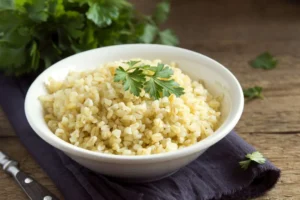Table of Contents
What is Bulgur Wheat?

Bulgur Wheat: Health Benefits, Nutrition, and Recipes
Nutritional Profile of Bulgur Wheat
Bulgur wheat is a powerhouse of nutrients. A one-cup serving (182 grams) of cooked bulgur provides:
- Calories: 151
- Carbohydrates: 33.9 g
- Fiber: 8.2 g
- Protein: 5.6 g
- Fat: 0.4 g
- Manganese: 48% DV
- Magnesium: 14% DV
- Iron: 10% DV
Bulgur is also rich in B vitamins, including niacin, vitamin B6, and folate, which support metabolism and energy production. Its high fiber content promotes digestive health and helps regulate blood sugar levels.
Health Benefits of Bulgur Wheat
1. Supports Heart Health
Bulgur wheat is rich in fiber and antioxidants, which help reduce inflammation and lower cholesterol levels. Studies have shown that consuming whole grains like bulgur can reduce the risk of cardiovascular disease. According to research published in the Journal of Nutrition, whole grain intake is associated with improved heart health and lower inflammation markers.
2. Improves Digestion
The high fiber content in bulgur wheat aids digestion by promoting regular bowel movements and preventing constipation. Fiber also supports a healthy gut microbiome, which is essential for overall digestive health.
3. Regulates Blood Sugar
Bulgur has a low glycemic index, meaning it releases sugar slowly into the bloodstream. This makes it an excellent choice for individuals with diabetes or those looking to manage their blood sugar levels.
4. Aids Weight Loss
Bulgur wheat is low in calories but high in fiber, making it a filling and satisfying food. Its ability to promote satiety can help reduce overeating and support weight management.
5. Boosts Immunity
Rich in vitamins and minerals like manganese, magnesium, and iron, bulgur wheat supports immune function and overall health. Its antioxidant properties also help combat oxidative stress and inflammation.
How to Cook Bulgur Wheat
Bulgur wheat is incredibly easy to prepare. Here’s a simple method:
- Combine one part bulgur wheat with two parts water or broth.
- Bring to a boil, then reduce heat and simmer for 10-15 minutes.
- Remove from heat, cover, and let it sit for 5 minutes.
- Fluff with a fork and serve.
For finer bulgur, you can simply soak it in boiling water for 15 minutes, then drain and fluff.
Bulgur Wheat Recipes
1. Tabbouleh Salad
Combine cooked bulgur wheat with chopped parsley, mint, tomatoes, cucumbers, lemon juice, and olive oil for a refreshing and nutritious salad.
2. Bulgur Pilaf
Sauté onions, garlic, and vegetables in olive oil, then add cooked bulgur wheat and season with herbs like thyme and oregano for a hearty side dish.
3. Breakfast Porridge
Cook bulgur wheat with milk or plant-based milk, and top with fruits, nuts, and a drizzle of honey for a wholesome breakfast.
Bulgur Wheat vs. Quinoa
Both bulgur wheat and quinoa are nutritious whole grains, but they have some differences:
- Fiber: Bulgur wheat has more fiber than quinoa, making it better for digestion.
- Protein: Quinoa is slightly higher in protein, but both are excellent plant-based protein sources.
- Gluten: Quinoa is gluten-free, while bulgur contains gluten.
- Calories: Bulgur is lower in calories compared to quinoa.
For more information on gluten-free alternatives, visit Healthline.
Risks and Side Effects
While bulgur wheat is generally safe for most people, it contains gluten, making it unsuitable for those with celiac disease or gluten sensitivity. Additionally, bulgur contains oxalates, which may contribute to kidney stones in susceptible individuals. Moderation is key, especially for those with kidney issues.
Conclusion
Bulgur wheat is a versatile, nutrient-dense whole grain that offers numerous health benefits, from supporting heart health to aiding digestion and weight loss. Its quick cooking time and mild flavor make it an excellent addition to a variety of dishes. Whether you’re making tabbouleh, pilaf, or breakfast porridge, bulgur wheat is a healthy and delicious choice. For more tips on incorporating whole grains into your diet, check out Whole Grains Council.